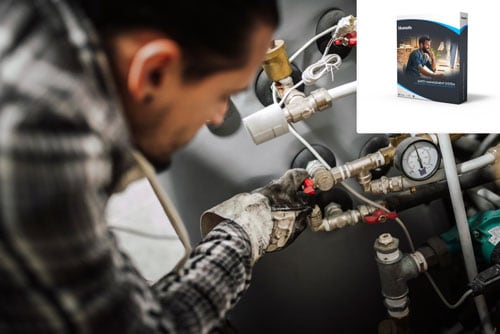Introducing the Plumbing and Gas Fitting Safety Management System – A comprehensive solution for businesses operating in the plumbing and gas fitting industry. This system includes a comprehensive Industry Policy and Procedures Induction Manual, a WHS Diary, and task and equipment specific Safe Work Method Statements (SWMS), helping you to ensure your business is fully compliant with all relevant safety regulations.
With a strong focus on safety and compliance, the Plumbing and Gas Fitting Safety Management System has been specifically designed to meet the needs of businesses in the plumbing and gas fitting industry. It provides a complete set of policies, procedures, and tools to ensure your business meets all the necessary safety requirements.
The Industry Policy and Procedures Induction Manual is a comprehensive guide that covers all aspects of safety management, including risk assessment, hazard identification, and safe work practices. It has been designed to be easy to understand and use, with clear and concise language and user-friendly formatting. The manual also includes a range of templates and checklists to help you implement the policies and procedures effectively.
The Policy and Procedures Manual for the Plumbing and Gas Fitting Work Health and Safety Management System has updated procedures for various aspects of work health and safety, including:
- Management of Health and Safety Risks
- General Tools and Equipment
- Drugs and Alcohol
- Company Vehicle Use
- Private Vehicle Use for Work Purposes
- Company Provided Mobile Phone Use
- Managing Noise and the Prevention of Hearing Loss
- Internet and Email Use
- Emergency Procedures
- First Aid Procedures
- First Aid Kit Checklist
- Hazardous Substances
- Rehabilitation
- Personal Protective Equipment
- Social Functions
- Slips Trips and Falls
- Work at Heights
- Sun Protection
- Managing Workplace Conflict
- Workplace Hazard Identification Inspections
- Incident Reporting
- Manual Handling & Hazardous Manual Tasks
- Fatigue Management
- Company and Personnel Privacy
- Smoking
- and more.
The WHS Diary is an essential tool for businesses to keep track of their safety management activities. It includes a range of sections to help you manage your safety management system effectively, including a register of incidents and hazards, a section for recording safety inspections, and a section for recording training and induction activities. The diary also includes a range of useful resources, such as a glossary of terms and a list of relevant legislation.
The WHS Diary Records Manual is a compilation of forms for any area of your safety compliance that needs to be recorded, which includes forms such as:
- Incident Report Form
- Hazard Identification Form
- Risk Assessment Form
- Toolbox Talk Sign-In Sheet
- Training Record Form
- Safety Inspection Form
- Personal Protective Equipment (PPE) Checklist
- Fire Safety Checklist
- Emergency Evacuation Plan
- First Aid Report Form
- Injury and Illness Record Form
- Chemical Register Form
- Safety Meeting Minutes Form
- Work Permit Form
- Equipment Inspection Form
- Job Safety Analysis (JSA) Form
- Safety Observation Report Form
- Confined Space Entry Permit Form
- Lockout/Tagout Form
- Safety Audit Checklist
As part of the Plumbing and Gas Fitting Work Health and Safety Management System, we offer 30 industry-specific Safe Work Method Statements (SWMS) that are specifically selected by you.
You’ll select up to 30 task and equipment specific Safe Work Method Statements (SWMS), which provide detailed instructions on how to perform specific tasks safely. These statements are designed to be easy to use, with clear and concise instructions that are tailored to the specific equipment and tasks involved. Each SWMS includes a range of useful resources, such as hazard identification checklists and risk assessment tools.
One of the key benefits of the Plumbing and Gas Fitting Safety Management System is its two-year update coverage. This means that your business will be kept up-to-date with any changes in safety regulations or industry standards, ensuring you always have the most current information available. This is particularly important in an industry like plumbing and gas fitting, where safety regulations are constantly evolving.
The Plumbing and Gas Fitting Safety Management System is also fully customisable, with your company logo and details added to all documents. This ensures that your business has a professional and consistent image, while also helping to build trust with your customers and stakeholders.
Finally, the Plumbing and Gas Fitting Safety Management System is delivered in Microsoft Word format for easy editing. This means that you can customise the documents to suit your specific business needs, and easily add or remove information as required. The system is also fully compatible with a range of other software tools, such as spreadsheets and project management software.
In conclusion, the Plumbing and Gas Fitting Safety Management System is an essential tool for any business operating in the plumbing and gas fitting industry. With its comprehensive range of policies, procedures, and tools, it provides everything your business needs to ensure compliance with all relevant safety regulations. Its two-year update coverage and customisable format make it a flexible and reliable solution that can be tailored to meet the specific needs of your business.
Ordering and Delivery
The system will be delivered in adherence to the legislation operative in your state. If your business operates nationally, be sure to let us know in the notes section when ordering, so we can ensure your package covers all the relevant jurisdictions your business operates in.
Delivery time is 7-10 business days. However if your order is urgent you may select express delivery during checkout and we’ll have your package to you within 3-5 business days.
Gary’s Safety Tips 
Hey, what’s up everyone? It’s your mate Gary here and today I want to talk to all the plumbers and gas fitters out there about working safely on the job.
As you know, working as a plumber or gas fitter can be a dangerous job if you’re not careful. One wrong move and you could end up with a serious injury or worse. That’s why it’s so important to always prioritised safety on the job.
In Australia, there are a number of legislative requirements that plumbers and gas fitters need to be aware of when it comes to working safely. For example, the Occupational Health and Safety Act 2004 and the Occupational Health and Safety Regulations 2017 set out specific requirements for working safely in the plumbing and gas fitting industry.
One of the most important things to remember when working as a plumber or gas fitter is to always wear the appropriate personal protective equipment (PPE). This includes things like safety glasses, gloves, and respirators. PPE is designed to protect you from potential hazards on the job, so it’s important to make sure you’re wearing the right gear for the task at hand.
Another key aspect of working safely as a plumber or gas fitter is to make sure you’re following all of the relevant safety procedures and protocols. This might include things like following lockout/tagout procedures when working on equipment, ensuring that gas lines are properly vented before beginning work, and making sure that all equipment is properly grounded before use.
In addition to these general safety practices, there are also specific safety requirements that plumbers and gas fitters need to be aware of. For example, under the Gas Safety Act 2017 and the Gas Safety (Gas Installation) Regulations 2018, gas fitters must hold a valid license and be registered with the relevant state or territory authority in order to carry out gas fitting work.
Similarly, plumbers who work on sanitary plumbing and drainage systems must hold a license and be registered with the Plumbing Industry Commission in Victoria, or the relevant state or territory authority in other states and territories. These licensing requirements are in place to ensure that only qualified and competent individuals are carrying out plumbing and gas fitting work.
In addition to these regulatory requirements, there are also a number of industry best practices that can help plumbers and gas fitters work safely on the job. For example, taking regular breaks and staying hydrated can help prevent fatigue and reduce the risk of accidents and injuries.
Similarly, it’s important to make sure that you’re properly trained and competent in the tasks you’re carrying out. This might mean completing additional training or qualifications in order to build your skills and knowledge.
Ultimately, working safely as a plumber or gas fitter requires a combination of knowledge, skill, and attention to detail. By staying up-to-date with the latest legislative requirements, following best practices for safety, and always prioritising the health and wellbeing of yourself and others on the job, you can help ensure that you’re working safely and effectively as a plumber or gas fitter.
So there you have it, folks – some key tips and advice on how to work safely as a plumber or gas fitter in Australia. Remember, safety should always be your number one priority on the job, so make sure you’re following all of the relevant regulations and best practices to stay safe and secure on the job.
Best regards,

![]()





